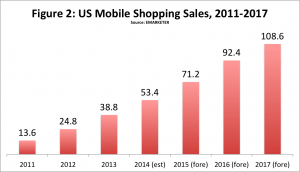
Mobile Advertising and Shopping
Just when you thought you had a pretty good handle on traditional and online advertising, along came mobile. While the medium is too new for most small businesses to claim expertise, changes in devices from smart phones to tablets are making mobile more compelling every day.
According to the Mintel Study, Mobile Advertising and Shopping 2014, here’s what’s new and why mobile advertising is giving small businesses more reasons to consider adding it to the mix.
Screens are getting bigger
Manufacturers from Apple to Samsung are creating devices with larger screens – up to 6.3 inches wide on Samsung’s Mega. Now ads consumers used to have to squint to read and interact with will be much easier to navigate.
Even so, users may need some positive reinforcement to fully embrace mobile advertising. The Mintel study revealed that a significant number of device users – 45 percent – felt their phones were still too small for ads to be effective. In a study of 2,000 internet users aged 18+, very few responded that they didn't mind seeing ads on their phone [See Figure 1].
The implications here are interesting. On one hand, larger ads are a good thing, but on the other, consumers still aren’t completely comfortable with them, perhaps because they’re still smaller than something they might experience on a laptop or larger screen device, like an iPad.
For businesses to successfully advertise using mobile, the study concludes that they should be extremely thoughtful about the user experience. From ad design to navigation to conversion, every element should be flawlessly thought out and executed with the customer in mind.
While you may be comfortable conceiving and developing traditional advertising, such as printed sales ads or fliers, tackling a new animal like mobile may require the expertise of an agency or specialist proficient in the medium.
Mobile purchases are slowly growing
 According to the Mintel study, mobile purchases are projected to grow from $53 billion in 2014 to $109 billion in 2017 [See Figure 2].Impressive when you consider the phenomenon of mobile purchasing only recently emerged from its infancy.
According to the Mintel study, mobile purchases are projected to grow from $53 billion in 2014 to $109 billion in 2017 [See Figure 2].Impressive when you consider the phenomenon of mobile purchasing only recently emerged from its infancy.
However, it still takes a back seat to traditional shopping online with a laptop or PC. During the same time period, these types of purchases are projected to rise by a factor of $84 billion – just short of twice as much.
While this would tempt some marketers to scrap mobile advertising for traditional online advertising, this shortsighted strategy neglects that fact that mobile is not going away, and will, in fact, continue to climb in purchasing dollars.
Devices are evolving at a pace that brings the user experience closer to PCs and laptops every day. Users, too, are becoming more sophisticated in their ability to navigate mobile advertising and accept it as part of the landscape.
Keep moving in step with mobile
For your business to evolve, it makes sense to open up to the possibilities mobile advertising can bring. If you’re not currently using mobile, now is the time to get up to speed. And if you are, it could be the dawning of a new dimension in customer relationships.
The trends, insights, and solutions you need to grow your business.
By signing up, you’re subscribing to our monthly email newsletter, The
Wire. You may unsubscribe at any time.
Your information stays safe with us. Learn more about our privacy
policy.











![[#MSP_NAME#] Logo](/themes/sparklight_business/images/transition-logos/migration-banner-logo-[#MSP_CD#].png)
